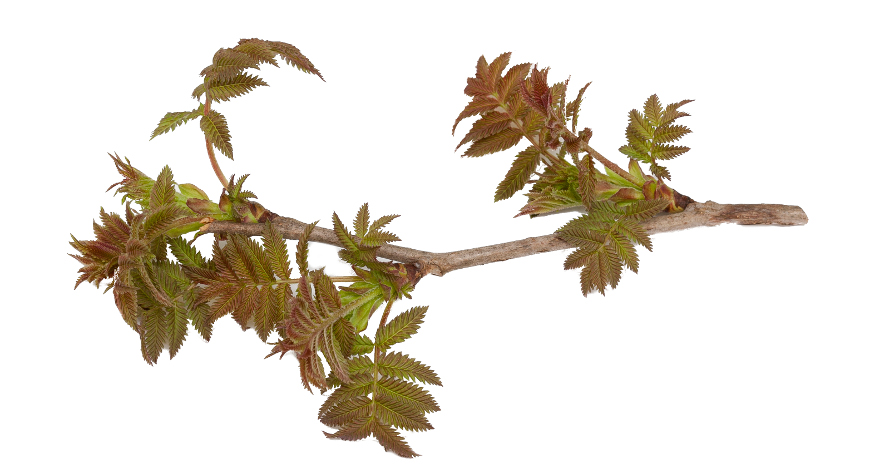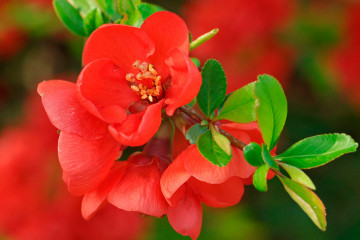Fieldfare - a shrub with leaves like rowan
Content:
Fieldfare is a deciduous shrub that forms dense thickets. Due to its high decorative characteristics, it is widely used in the field of landscape design for the organization of planting. Often, mountain ash-leaved shrub is used for hedges.
Origin and appearance
Fieldfare bush (Latin Sorbaria) belongs to the Pink family. The plant is found in many Asian countries.
The genus is represented by only 10 varieties of culture. The name that the bush has comes from "sorbus", which means "mountain ash" in Latin. A similar name is associated with the fact that the leaf plates of this culture are almost identical to rowan ones. The only difference is that the rowan leaf is usually slightly larger.
As an ornamental plant, fieldfare has been planted for a long time - from about the 18th century.
The plant is characterized by sinuous gray-yellow stems. The bush itself can grow up to 3 meters. Flowers of an ornamental shrub form panicle-shaped inflorescences in the form of a pyramid, consisting of a large number of small flowers. The latter can be white or cream in color.
Flowering features
Fieldfare flowers are fragrant and look very impressive against the background of bright greenery. In order to preserve the decorative appearance of the culture for the longest possible time, the faded panicles are removed, since the fruits of the plant are not distinguished by their beauty. The plant has a very long flowering period - from June to August.
The first time a shrub with leaves like rowan blooms in the third year after planting.
Fieldfare in landscape
Rowan-leaved, like chokeberry, is actively used in landscape design by both professionals and amateurs.
Its white and beige flowers look very beautiful in any composition. The plant is combined with almost all flowers and shrubs. Most often, a mountain ash-like shrub is used in the following cases:
- As the center of a flower arrangement surrounded by different flowers.
- As part of a hedge.
- As a companion to tall large trees (hides a long trunk with its foliage).
- Combined with all kinds of conifers.
Varieties for the middle lane
For planting in the climatic conditions of central Russia, the Pallas and Sam varieties are suitable.
Fieldfare of Pallas
The variety grows in Siberia, the Far East, as well as on the slopes of the Alps. This suggests that the plant is perfectly adapted to both harsh conditions and sudden temperature changes.
The mountain ash leaf grows not too high - up to 1.2 meters. It is characterized by a very curvy round shape. The leaf plates are large enough - up to 15 cm, are placed on the petiole in an amount of up to 15 pairs and have a dark green color. The inflorescences are many white or cream-colored buds. Their diameter can be up to 1.5 cm.
Fieldfare Sam
The Sam variety has a round compact shape and grows to a height of no more than 80 cm.The foliage of the bush has a light green tint with a reddish or bronze tint. It blooms with white buds, which gather in slightly elongated inflorescences. The stamens of the flowers are twice as long as the petals, which gives the shrub a particularly elegant appearance.
Landing in open ground
It is not difficult to plant a shrub with leaves like rowan in open ground.
What is needed for landing
All that is required for planting a crop outdoors is a basic knowledge of the plant and its needs and the desire to grow a beautiful shrub.
Another point that you need to pay attention to is the right timing for planting a bush. As a rule, planting should be done in early spring before the start of sap flow or in the fall after the fall of the foliage.
Where to plant
Since fieldfare is a highly shade-loving plant, it should not be placed in open sunlight. The shrub will feel much more comfortable in the shade. That is why the culture is often planted under tall villages.
As far as soil is concerned, any type of fertile will do. The plant will feel equally comfortable both in damp and loose soil, and in dense clay.
Planting step by step
Planting a bush in open ground involves a number of steps:
- Dig a hole in the open ground with a depth of about 40 cm.
- The bottom of the pit is covered with drainage material.
- A small amount of planting soil is poured onto the drainage.
- Nitrogen-containing fertilizing is added to the ground in the amount recommended by the manufacturer.
- A seedling is placed in the pit.
- Gently sprinkle the plant with earth and tamp it lightly.
- A neat hole is made near the trunk to prevent moisture from spreading during watering.
- Water the seedling.
Fieldfare propagation
Most often, fieldfare is propagated in one of the following ways:
- cuttings;
- from layering.
Cuttings
The description of propagation by cuttings does not imply particularly complex manipulations. Therefore, the method is used in practice more often than others. Cuttings are taken from sturdy woody stems. Their length should be 20-30 cm. For rooting, cuttings are planted in a container with soil. Further, it remains only to carefully ensure that the soil remains moist throughout the entire rooting process of the future shrub.
From layering
It is quite easy to propagate fieldfare from cuttings. To do this, in the spring, take a long and (necessarily!) Completely healthy stem. It is carefully bent to the ground so that the kidneys are in contact with the ground. In this position, the stem is fixed, slightly covering it with earth. It is very important that the tip is on the surface. After a while, the rooting will take place, at the end of summer it will remain to be cut off from the mother plant and transplanted.
Rowanberry shrub in terms of planting and care does not create any particular problems. In order for the cultivation to be successful, and the plant began to bloom, you need to follow some rules regarding watering, feeding and preparing the plant for winter.
Care
Watering
Fieldfare is an unpretentious plant, it is easy to take care of it. But he cannot do without regular watering. The culture does not tolerate drying out very well. It is especially important to moisten the soil immediately after planting.
On average, two plentiful watering (2 buckets of water for each bush) within a month is enough for a shrub. If the summer is hot and dry, it is recommended to double the number of procedures performed.
Top dressing
The field plant is in vital need of regular application of organic fertilizers to the soil. You can add organic matter directly to the surface of the trunk circle in small portions.
Of the mineral compositions, the bush needs nitrogen, potassium and phosphorus.It is allowed to introduce useful elements into the soil in the form of granules without prior dissolution in water. For 1 square meter of planting, 20 grams of universal mineral fertilizer is enough.
During flowering
The plant does not need any special care during the flowering period. It is enough to ensure that the soil directly under the bush never dries out, and from time to time (as it dries) remove wilted inflorescences.
At the end of flowering
After the fieldfare has completely bloomed, all inflorescences and fallen leaves are removed. At the same time, the number of waterings is reduced to a minimum.
Preparing for winter
Due to the high level of frost resistance, the field ash does not need to be prepared for the winter period - it tolerates even the most severe frosts without insulation.
Video



















